Meet the three anteaters of Brazil
Anteaters appeared about 55 million years ago, between the Paleocene and Eocene epochs, when they diverged from sloths. Of the anteaters that exist today, the oldest are the silky anteaters, which appeared 30 million years ago during the Oligocene Era. It was only 20 million years later, during the late Miocene, that the giant anteaters and the southern tamanduas appeared1.
Although the giant, southern, and silky anteaters are visually similar to some extent, their long evolutionary history has resulted in very different behaviors and physical adaptations.
Giant anteater (Myrmecophaga tridactyla)
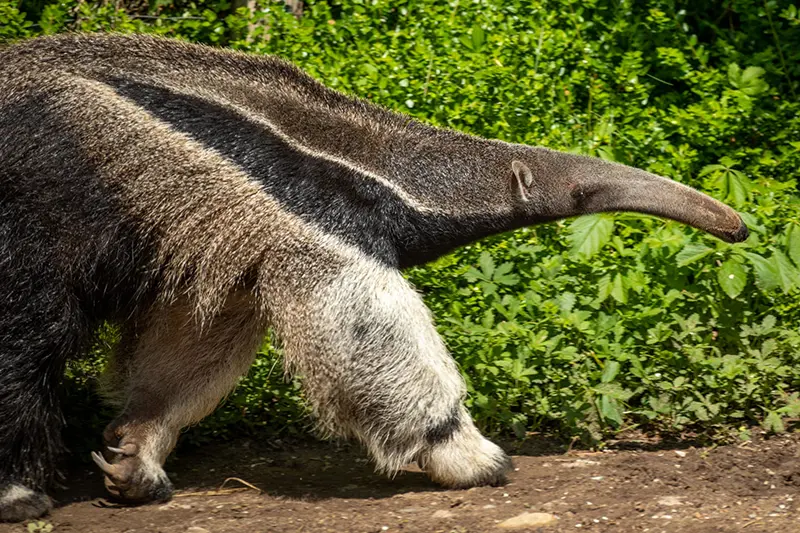
The giant anteater is part of the Myrmecophagids family (Myrmecophagidae) along with the Southern tamandua. It is the only living representative of its genus (Myrmecophaga), but researchers suggest that there are three subspecies: the subspecies M. t. centralis is found in Central America and north of the Andes; M. t. artata in northern Colombia and northwestern Venezuela, while in the rest of South America and Brazil we find the subspecies M. t. tridactyla.2
The giant anteater always catch our attention for their peculiar appearance. Although its large claws can pierce flesh, they are used mainly to destroy the tough termite mounds and anthills. Due to the long length of these claws, the giant anteater usually walks on its knuckles, that is, it relies on its three middle toes to walk (nodopedalic posture) - like gorillas and chimpanzees.3 The hind legs, however, have short claws, and the animal can walk with the whole paw on the ground, like primates and rodents - typical locomotion of plantigrade animals.4
Its snout of up to 30 cm (1 ft) and its sticky tongue of up to 60 cm (2 ft) 5 allow it to reach and capture insects in the deepest parts. During feeding, the anteater’s tongue can extend and contract up to 160 times per minute, allowing it to consume up to 30,000 insects per day. Furthermore, anteaters can reach over 2 m (6.5 ft) in length and weigh up to 50 kg (110 lb) feeding almost exclusively on termites and ants.
Although they have poor eyesight and hearing, this is compensated by their sense of smell, which is 40 times better than that of humans. They use their sense of smell to find specific species of termites and ants to feed on, such as fire ants.
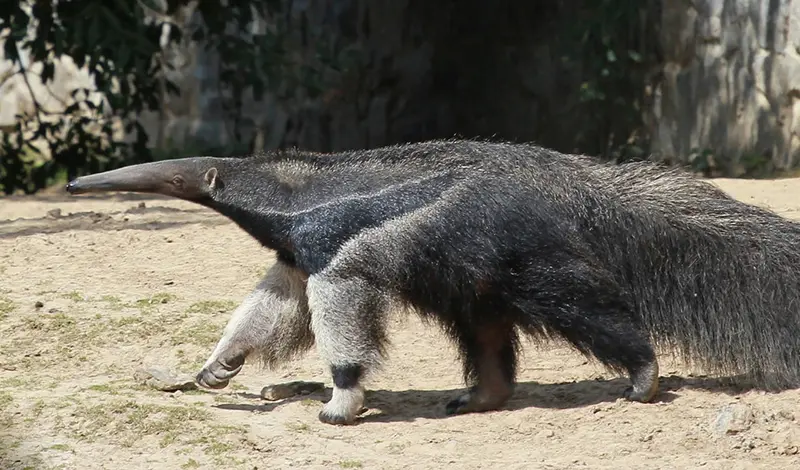
The giant anteater prefers to forage in open areas, but may use forests and wetter areas to rest and regulate its body temperature. Its dense fur acts as a thermal barrier, conserving body heat during cold hours and preventing overheating during the hottest hours of the day.6
It is usually more active in the early evening, when the temperature is not so high, but on cold days it usually wakes up earlier and is fully diurnal,6 although in human-influenced environments it may be nocturnal because it feels safer.4
Conservation and Threats
The conservation status of the giant anteater varies from state to state and country to country. In some countries, such as Uruguay and Paraguay, it has been declared extinct, while in Central America it is critically endangered. In Argentina, it is considered “endangered” and its occurrence is increasingly limited to the north, having been extinct in the south7 4.
In Brazil, it is classified as “vulnerable” by ICMBio. Although its distribution covers all biomes, its status varies regionally: in Paraná and Rio Grande do Sul, it is considered “critically endangered”; in Espírito Santo, Rio de Janeiro and Santa Catarina it is probably extinct; in São Paulo it is “endangered”; and in Pará, it is considered “vulnerable."8 9
Still, there are no estimates of the number of existing individuals.4 The main threats to the species are hunting, habitat destruction, forest fires, and road kills.10 Despite the risk of various degrees of extinction, it can still be found in numerous protected areas, where it is often abundant.
Southern tamandua (Tamandua tetradactyla)
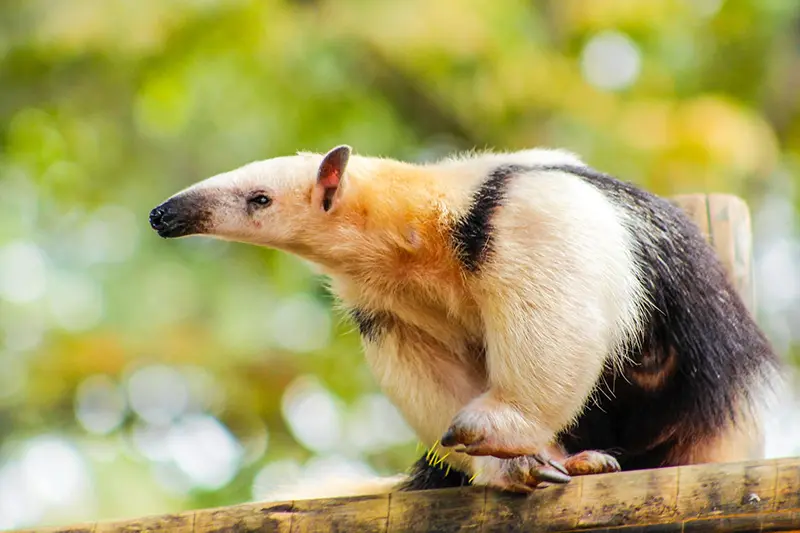
The Southern tamandua is part of the same family as the giant anteater (Myrmecophagidae). There are two kinds: the Northern tamandua (Tamandua mexicana) found from Mexico to Ecuador, and the Southern tamandua (Tamandua tetradactyla) — found all over Brazil and most of the other South American countries.
Four subspecies of Southern tamandua are recognized:
- T. t. nigra: can be found in the Guyanas, Suriname, Venezuela, and Colombia. In Brazil, it is found throughout the northern region and part of the northeastern region.
- T. t. quichua: found only in part of Ecuador, in Peru and, in Brazil, only in Acre.
- T. t. straminae: found in Bolivia, Paraguay, northern Argentina, and central-western Brazil.
- T. t. tetradactyla: inhabits the Atlantic Forest and the Pampas - from Rio Grande do Norte to the south of Rio Grande do Sul. [^12]
Unlike the giant anteater, the southern tamandua is mainly arboreal and can grow up to 1 meter long with the tail. They can be recognized by their coat pattern, which makes them look like they are wearing a “vest”, but not all subspecies have this pattern.
This black “vest” is only present in specimens living further south and southeast of their range. The other subspecies are often completely yellow, brown, black, or have a faint vest pattern.11
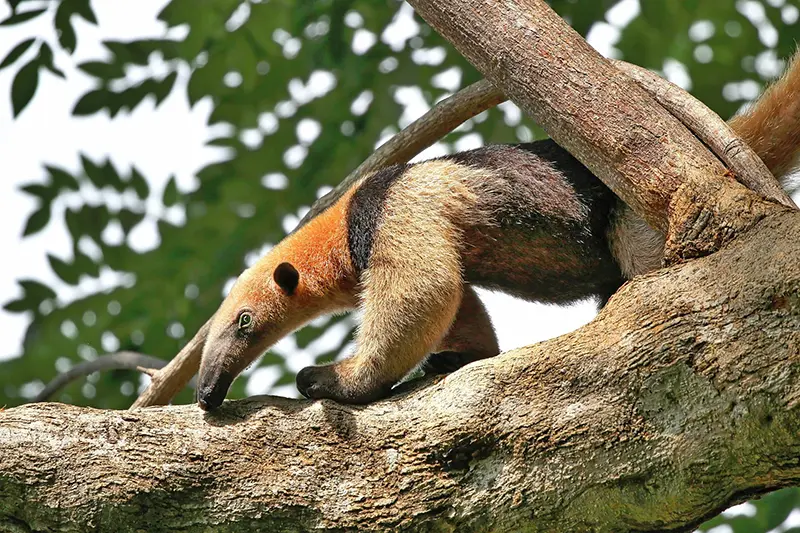
The southern tamandua has four toes on its front legs, with the claw on the third toe being the largest of all. Unlike the giant anteater, which walks on its knuckles, the southern tamandua rests its weight on its wrists, which are covered with a very thick layer of skin. Because of this, they walk awkwardly on the ground and are unable to run.
The skull is elongated, up to 16 centimeters (2.3 in) long, it also has no teeth and has a tongue up to 40 centimeters (1.3 ft) long. It has a prehensile, hairless tail on the underside.
Like the giant anteater, the Southern tamandua has poor eyesight and hearing, but a very developed sense of smell. hly developed sense of smell. They are also solitary, diurnal animals, but may be nocturnal in human-influenced regions12.
Conservation and Threats
The southern tamandua is listed as " Low Concern” by the International Union for Conservation of Nature (IUCN). It has a wide geographic distribution and is relatively common in the places it inhabits, although local extinctions have occurred.
Although hunting for food, illegal sale as pets, and predation by dogs represent a threat to the survival of the population, the species appears to be thriving and is not considered endangered.12
Silky anteaters (Cyclopes ssp.)
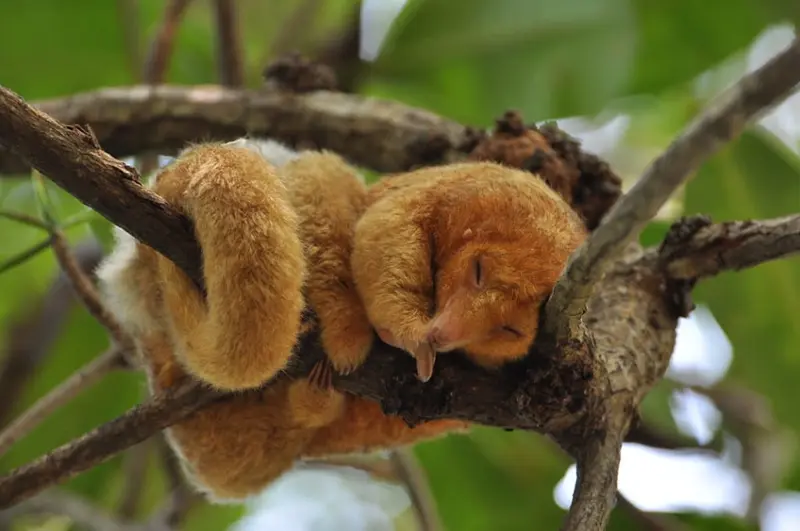
The silky anteater is not only the oldest anteater, but also the most different. First, the silky anteater has the largest number of species. There are currently seven recognized species, five of which are found in Brazil:
- Northeastern Silky Anteater (C. didactylus): inhabits central and northern South America and the Atlantic Forest of the northeast;
- Red Silky Anteater (C. rufus): found only in the state of Rondônia, between the Madeira and Aripuanã rivers.
- Thomas's Silky Anteater (C. thomasi): found in the state of Acre, and in Peru.
- Xingu Silky Anteater (C. xinguensis): inhabits only the Xingu River basin, in the state of Pará.
- Rio Negro Silky Anteater (C. ida): inhabits the Amazon rainforests of Colombia, Ecuador, Peru, and Brazil.
- Northern Silky Anteater (C. dorsalis): found in Central America, and part of Colombia and Ecuador.
- Amboro Silky Anteater (C. catellus): found only in Bolivia.[^14]
Its yellowish color varies according to the region it lives in: the further south it lives, the more grayish its fur becomes and the darker its stripe. Conversely, the farther north it lives, the more yellowish its fur becomes and the paler the stripe on its back.13 14
The silky anteater is very difficult to see and therefore little studied. The silky anteater is small, measuring about 50 cm including the tail, and weighing about 400 g. It spends the day sleeping curled up in the canopy and only becomes active at night, and even then it doesn’t go very far - it rarely comes down to the ground. 15
It has four functional toes on its hind legs, and its ankles can rotate up to 180° - which helps it cling to trees. On the front legs, however, the first and fourth toes are atrophied and practically invisible. Only the second and third are functional, with the third having the largest claw - giving the impression that it has only one finger.16 13 It also has a large prehensile tail, about 10 inches (25 cm) long, which acts as a fifth limb.
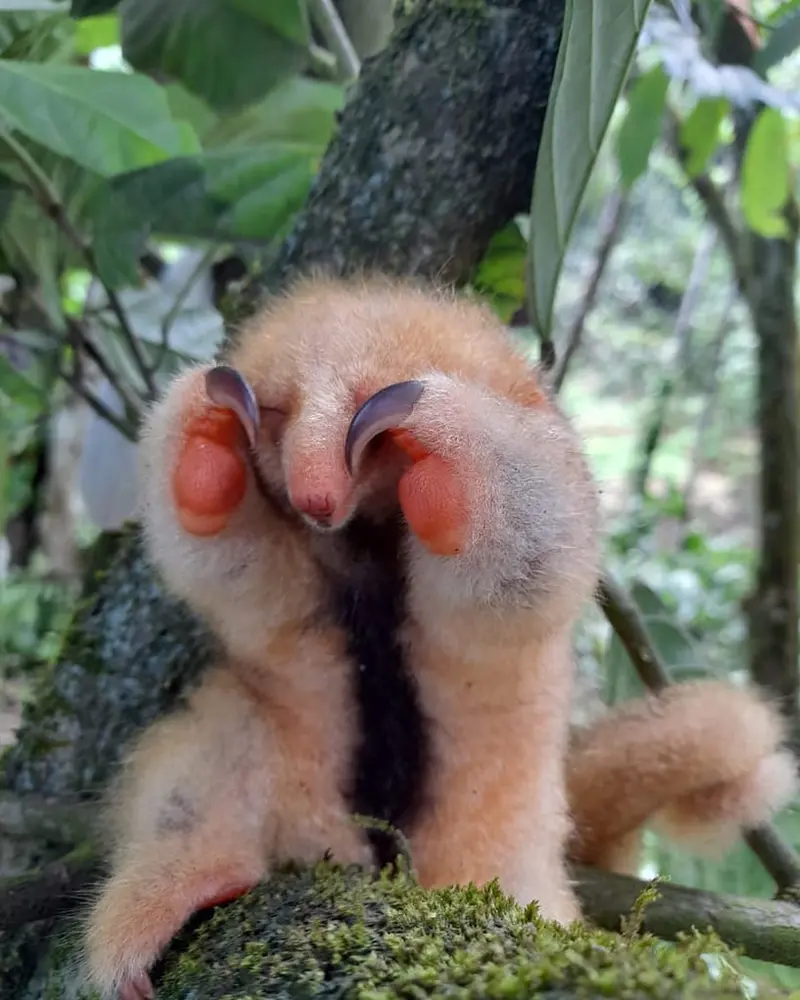
Instead of digging up colonies, it uses its claws to rip out wood splinters and capture ants living inside logs, consuming an average of three to eight thousand of these insects in a single night-rarely feeding on termites.15 Like other anteaters, silky anteaters never eat all the insects in a colony, instead feeding on a small percentage and moving on to the next one, conserving their food source for when they return.
Despite what appears to be a large amount of ants, the silky anteater barely gets enough energy to get through the day.15 While resting, it enters a state of torpor that lowers its body temperature and metabolic rate to the point where it appears to be in a coma. As radical as it is, this is a necessary step to get enough energy to get through the next day.15
In addition to all of these unusual characteristics, the silky anteater also has a slightly different defense technique than its cousins. While the giant anteater and the southern tamandua open their arms sideways and quickly grab anything that comes their way with their claws. The silky anteater clings to the nearest branch with its tail and raises its front paws close to its head, positioning itself like a small, fluffy boxer.13
Conservação e Ameaças
Trafficking as pets is common in the Amazon region and is one of the main threats identified. They are also threatened by the reduction and fragmentation of their habitat and by forest fires.
Read more:
-
Delsuc, F., Vizcaíno, S.F. & Douzery, E.J. Influence of Tertiary paleoenvironmental changes on the diversification of South American mammals: a relaxed molecular clock study within xenarthrans. BMC Evol Biol 4, 11 (2004). https://doi.org/10.1186/1471-2148-4-11 ↩︎
-
Carrillo, Juan D. & Sibira, Luis & Barros, Tito. (2022). Cranial anatomy of the giant anteater from northwestern Venezuela (Myrmecophaga tridactyla artata, Pilosa: Myrmecophagidae). Anartia. 34. 9-17. 10.5281/zenodo.7131289 ↩︎
-
Orr, C.M. (2005), Knuckle-walking anteater: A convergence test of adaptation for purported knuckle-walking features of african Hominidae. Am. J. Phys. Anthropol., 128: 639-658. https://doi.org/10.1002/ajpa.20192 ↩︎
-
Smith P - Myrmecophaga tridactyla - FAUNA Paraguay Handbook of the Mammals of Paraguay ↩︎
-
Ecologia e Comportamento de Giant anteater (Myrmecophaga Tridactyla Linnaeus, 1758) no Município de Jaguariaíva, Paraná. ↩︎
-
Mourão, G. and Medri, Í.M. (2007), Activity of a specialized insectivorous mammal (Myrmecophaga tridactyla) in the Pantanal of Brazil. Journal of Zoology, 271: 187-192. https://doi.org/10.1111/j.1469-7998.2006.00198.x ↩︎
-
Contribución al Conocimiento de la Distribución del Oso Hormiguero Gigante (Myrmecophaga tridactyla) en Argentina ↩︎
-
Livro Vermelho da Fauna Brasileira Ameaçada de Extinção Volume II – Mamíferos ↩︎
-
Lista dos mamíferos do Estado de Santa Catarina, Sul Do Brasil ↩︎
-
Adriano G Chiarello, Effects of fragmentation of the Atlantic forest on mammal communities in south-eastern Brazil, Biological Conservation, Volume 89, Issue 1, 1999, Pages 71-82, ISSN 0006-3207, https://doi.org/10.1016/S0006-3207(98)00130-X. ↩︎
-
Mammal Species of the World: A Taxonomic and Geographic Reference, Volume 1 ↩︎
-
Hayssen, V.. (2011). Tamandua tetradactyla (Pilosa: Myrmecophagidae). Mammalian Species. 43. 64-74. 10.1644/875.1 ↩︎
-
Virginia Hayssen, Flávia Miranda, Bret Pasch, Cyclopes didactylus (Pilosa: Cyclopedidae), Mammalian Species, Volume 44, Issue 895, 26 September 2012, Pages 51–58, https://doi.org/10.1644/895.1 ↩︎
-
Miranda, Flávia & Casali, Daniel & Perini, Fernando & Machado, Fabio & Santos, Fabricio. (2018). Taxonomic review of the genus Cyclopes Gray, 1821 (Xenarthra: Pilosa), with the revalidation and description of new species. Zoological Journal of the Linnean Society. 183. 687-721. 10.1093/zoolinnean/zlx079 ↩︎
